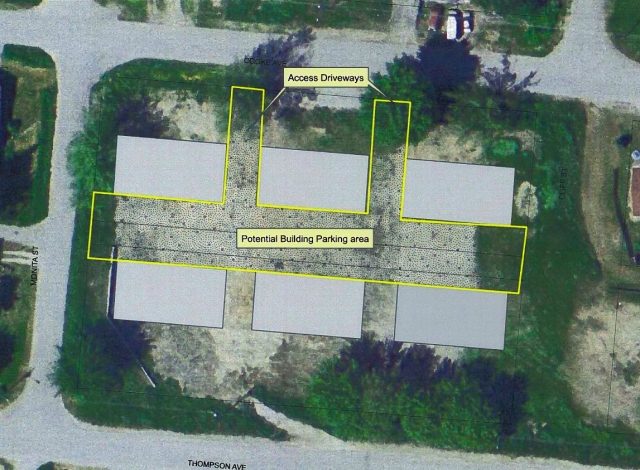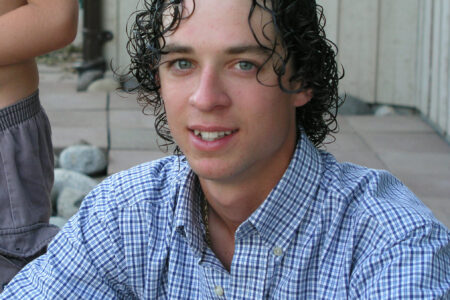Old Cooke school site could become 24 units of affordable housing, but developer stymied by city restrictions
The old Cooke Ave. school site may soon see construction as council advanced a zoning amendment that will allow local developer Cezary Ksiazek to build a group of six fourplexes. A public hearing is scheduled for Dec. 10 after which council will vote on third reading and adoption of the bylaw.
The plan council advanced, however, is “impossible,” according to Ksiazek, who says the stipulations attached to the zoning amendment will make it too expensive to build and maintain the fourplexes as “affordable housing,” his stated aim. Staff’s report to council is attached below.
Kiazek agreed to most of the conditions—namely that the Cliff St. right-of-way be restored as a greenbelt and that adequate snow storage be legally registered around the perimeter. He also says that $350,000 in water and sewer infrastructure will benefit the neighbours. But he looked at the city-approved parking and driveway plan in dismay and said, “I’m screwed.”
Ksiazek’s plan includes three fourplexes on Thompson Ave. and three on Cooke Ave. for a total of 24 units. Each unit requires two on-site parking spaces, one of which Ksiazek will provide in a single car garage per unit, and the other on the driveway directly in front of the garage. But while Ksiazek wants each fourplex to have two driveways—for a total of 12, six on Thompson and six on Cooke—city staff recommended against this configuration citing “operational concerns.”
The alternative they offered is two large driveways off Cooke into a paved interior courtyard, limiting the number of access points the city has to clear of snow, reducing congestion and parking on the Thompson Ave. bus route, and providing “traffic calming” by limiting “circulation impacts.” Staff argued that Ksiazek’s 12-driveway plan would make it more likely for cars to park parallel between driveways, impeding traffic flow and snow clearing.
Ksiazek, however, maintained that the fourplex between the two driveways on Cooke would have to be removed from the design to make room for snow removal, reducing the plan to 20 units in five fourplexes. He said the configuration would also saddle future residents with the need to contract a snow blower and loader to take the snow somewhere off site, at about $250 per hour. “You cannot dump the snow on city property,” Ksiazek said, such as the adjacent laneway, and he said there wouldn’t be room on the property itself.
He explained that the parcel is 300 feet long beside Cooke, and each fourplex is 80 feet long with a ten foot setback at either end, for a total of 260 feet accounted for. He said that doesn’t leave room for two 20 foot wide driveways. “There’s absolutely no discussion,” he said, “you have to take the fourplex out, period.”
Staff disagreed, however. They say the setbacks have been reduced to 2 metres (6 feet), leaving enough space (44 feet) for the two driveways without removing the fourplex between them. Staff added, “Residents throughout Rossland routinely pay for snow clearing services,” and noted, “The city has handled other multiple family dwelling developments in a similar manner,” pointing to the Centre Star/Le Roi/Monashee development as an example of 47 multiple family dwellings with only two access points.
Ksiazek opposed the city’s layout for other reasons. “In my design,” he said, “there is a huge green space in the backyard for the kids to play.” Under the city’s proposal, he said, “the backyard goes onto the street. It’s dangerous for kids playing in the backyard, it’s a safety issue.”
He added that the construction costs would be increased. “I would have to dig a lot of fill and move it towards Cooke to make it level,” he said, and suggested that the interior pavement would cost $250,000 more than if he were to build individual driveways.
In the end, he thinks it will make it more difficult to sell: “Who buys something with the backyard going onto the street? Who buys something with huge pavement at the front of the house?” he asked.
Overall, he said his aim is affordable housing, defining “affordable” as less than $300,000 per unit. Each unit would have about 1800 square feet of finished interior space, 2400 including the garage. He has two potential types of buyer in mind: young families with two kids for the three-storey units on Cooke, and “empty nester baby boomers” for the two-storey units on Thompson with the garage on the same level as the living room and kitchen, and the bedrooms below.
City staff pointed out that this is not necessarily the most-dense option. If the entire block were zoned R1 Detached Infill Residential like the surrounding neighbourhood, the block could fit up to 20 single family homes, each with a secondary suite for a total of 40 units requiring 60 parking spaces. Rezoning the entire block to 30′ by 100′ R1-Infill parcels like that would result in 20 driveways.
When council debated the zoning amendment bylaw on Nov. 12, councillors’ opinions varied on the parking layout, although everyone agreed with the logic of using the site for high density affordable housing.
Coun. Cary Fisher said, “I don’t really see how neighbours sharing snow plowing supports affordable housing.” Fisher added that traffic was not an issue: “We could add a thousand houses to Lower Rossland and still not need a traffic light,” he said.
Coun. Tim Thatcher agreed with the need for an affordable housing project, but said, “The only thing I have a problem with is the parking, the two alleys [driveways].”
Coun. Jill Spearn reiterated the good things about the project—affordable “multihousing”—and commended the potential to do something with the land that, “since the school’s destruction, has just been lying there fallow.” But, she said, “I don’t agree with the central road in the middle.” She argued that the Ksiazek’s plan had enough parking that “no one there needs to park on the road. “We need to support builders who want to infill,” she said, and argued that the “road in the middle” would increase costs to the eventual home owners.
Coun. Kathy Wallace called the old school lands lying vacant an “emotional scar in the community,” and said she would like to see “something happen on that site.” Wallace, however, gave her support to city staff’s idea of “clustering” the units’ parking layout. “I support what staff are doing,” she said, “It’s not about traffic, it’s about people parking on the side of the street. There’s potential for people to park parallel between driveways.”
Coun. Jody Blomme expressed her support for “diversifying the housing stock in Rossland,” particularly with units that cater to young families and seniors. She was concerned, however, about an inward-facing design that would have a “villa” feel, isolating it from the community. City staff responded that the direction the buildings faced would be entirely up to the developer.
Blomme was also ambivalent about the two-driveway design: “I don’t understand why it’s better,” she said. “It’s a residential neighbourhood. People do park between the driveways.”
City planner Mike Maturo responded, “In discussion with operations [staff], one of the biggest issues is Thompson Ave. as a local collector. As much as possible, we try to keep parallel parking from happening.” He cited examples of other developments in Rossland with internal circulation systems that work well. “The more driveways, the more time with the snow blower and dump trucks,” he said.
Fisher said he thought lots of people were going to fill their garages with “toys” and park parallel on the street in any case.
Mayor Greg Granstrom countered: “Snow removal is an issue, snow storage is an issue. There’s an increased cost to take it away. This configuration addresses that; it keeps costs down for the city.”
Spearn disagreed: “I feel strongly about the fact that this [affordable housing] is a potentially great service to our community. As long as we require the builder to build more infrastructure, we’re just shooting the costs up to the buyer. Snow removal is snow removal,” she said. “It’s always going to be challenging. I don’t think snow removal should drive the decisions we make. If it doesn’t happen, [if people don’t park on site,] we make do, we plow around. We want to attract more people and keep costs down. Operationally, we try and work around it.”
Ksiazek said he had other options with the site that could make more money, and has plans with other sites to do just that, but his plan at Cooke Ave is a community service. “I’m not building this to be greedy,” he said. “I make peanuts on this.”
Blomme and Spearn voted against the zoning amendment in its present form—which required the two-driveway design—while Granstrom, Fisher, Wallace, and Thatcher voted in favour. Coun. Kathy Moore was absent. A public hearing on the bylaw has been scheduled for Dec. 10.

























